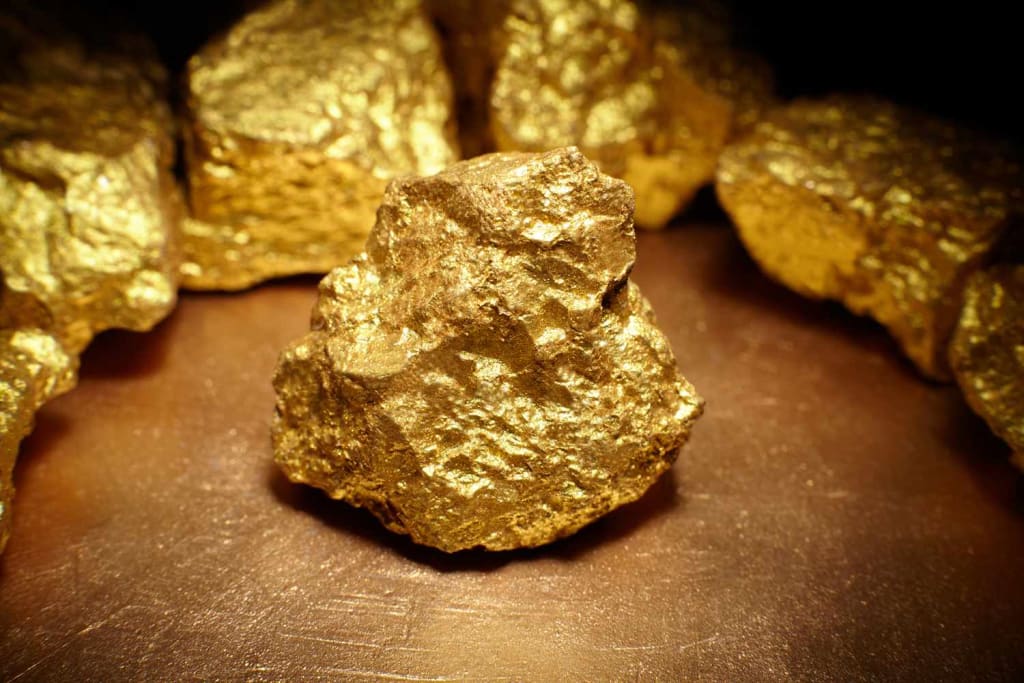The DISCOVERY OF GOLD
PRECIOUS METAL THAT SHAPED THE WORLD

Introduction
The discovery of gold has had a profound impact on human history, shaping economies, civilizations, and the course of exploration. This essay delves into the fascinating tale of how gold was discovered and its subsequent influence on societies across the globe. From the earliest known gold mines in ancient civilizations to the significant gold rushes that occurred in various parts of the world, we explore the far-reaching consequences of this precious metal's unearthing.
Ancient Origins and Early Mining Techniques
Gold has captivated human fascination since antiquity. The earliest evidence of gold mining dates back to around 3,000 BCE in present-day Egypt and Mesopotamia. Ancient civilizations, such as the Egyptians, Sumerians, and Nubians, recognized the allure of gold and crafted exquisite jewelry, ornaments, and ceremonial artifacts from this shimmering metal.
Early mining techniques primarily involved placer mining, where gold particles were extracted from rivers and streams by panning or using rudimentary tools like sluice boxes and rockers. These civilizations established prosperous trade routes to exchange gold and other valuable commodities, spreading the influence of gold throughout the ancient world.
The Impact of Gold on Ancient Empires
Gold played a pivotal role in the rise and fall of numerous ancient empires. The Egyptians amassed vast reserves of gold, which symbolized divine power and fueled their economic prosperity. Gold adorned the tombs of pharaohs, including the famous treasures of Tutankhamun, showcasing the significance of this precious metal in the afterlife.
The Greeks and Romans also revered gold for its beauty and monetary value. Gold coins became the primary medium of exchange, facilitating trade across vast territories and fostering economic growth. The Roman Empire, in particular, relied on gold to finance its ambitious conquests and maintain its military dominance.
Gold in the New World: The Spanish Conquest
The discovery of the New World in the 15th century brought forth an unprecedented wave of gold exploration. The Spanish conquistadors, driven by their lust for wealth and power, set their sights on the Americas. In 1492, Christopher Columbus's voyage to the Caribbean sparked a relentless pursuit of gold and other precious metals.
Spanish expeditions, led by figures like Hernán Cortés and Francisco Pizarro, plundered the Aztec and Inca civilizations, renowned for their gold treasures. The conquest of Mexico and Peru resulted in an influx of gold into Europe, transforming the economic landscape and fueling inflation.
Gold Rushes and the Expansion of Frontier Economies
The 19th century witnessed several gold rushes that dramatically altered the course of history and shaped the development of nations. The California Gold Rush of 1848 drew thousands of prospectors from around the world, leading to the rapid growth of San Francisco and the establishment of a diverse society in the American West.
Subsequent gold rushes occurred in Australia, South Africa, and Canada, with each wave of prospectors bringing immense wealth and transforming these regions into bustling centers of economic activity. These gold rushes also facilitated the exploration and colonization of previously untamed lands, fueling technological advancements and fostering global interconnectedness.
Modern-Day Significance and Uses of Gold
In the contemporary world, gold continues to play a vital role in various sectors. It serves as a safe-haven investment during economic uncertainties, ensuring stability and preserving wealth. Gold also finds its place in jewelry and the manufacturing of electronic components, due to its excellent conductivity and corrosion resistance.
Moreover, central banks hold substantial gold reserves, bolstering national economies and instilling confidence in financial systems. The establishment of the gold standard, which linked currencies to
Gold, a precious metal revered for its beauty and value, has played a significant role throughout human history. In the context of the early 2000s, the price of gold experienced notable fluctuations and witnessed both highs and lows.
At the beginning of the 2000s, gold was trading at relatively low levels, hovering around $300 to $400 per ounce. However, as the decade progressed, several global events led to an increase in gold's price. The 2008 financial crisis, characterized by economic uncertainty and a loss of confidence in traditional financial instruments, prompted investors to seek refuge in gold. Consequently, the price of gold surged to around $1,000 per ounce by 2008.
In the following years, gold continued its upward trajectory, driven by ongoing economic uncertainty, geopolitical tensions, and a desire for asset diversification. In 2011, gold reached its all-time high, surpassing $1,900 per ounce. However, as global economic conditions improved and risk appetites returned, the price of gold experienced a gradual decline.
By the end of the 2000s, gold was trading around $1,200 to $1,300 per ounce. It remained relatively stable, with minor fluctuations, until the end of the decade.
Gold's value in the 2000s was influenced by a myriad of factors, including economic conditions, investor sentiment, geopolitical events, and fluctuations in currency markets. Despite the variations in its price, gold has consistently maintained its allure as a store of value, a hedge against inflation, and a safe-haven asset for investors seeking stability during times of uncertainty.





Comments
There are no comments for this story
Be the first to respond and start the conversation.